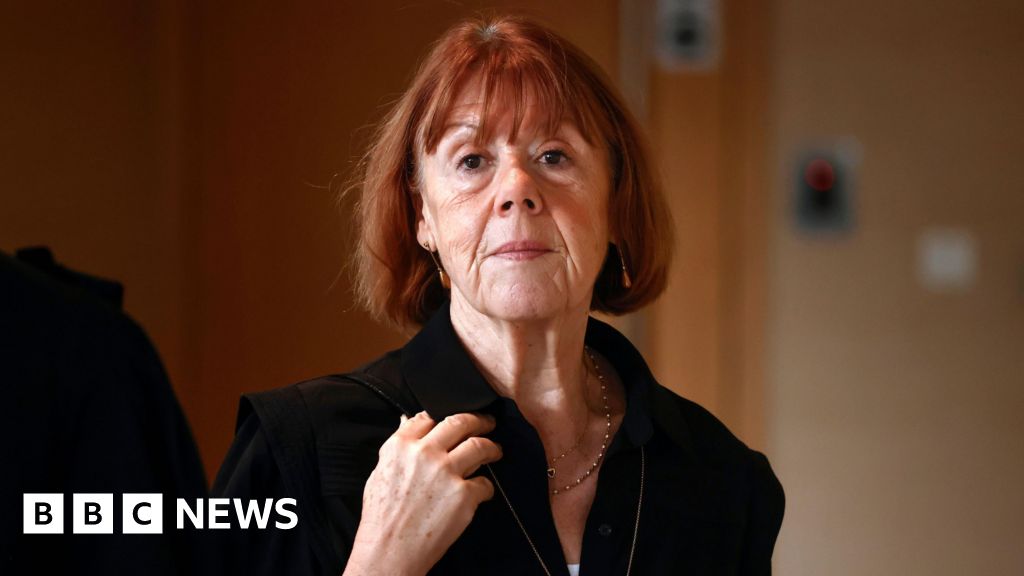
 EPA
EPAWarning: This story contains descriptions of alleged sexual offences.
There was a moment, a few weeks into the trial, when Gisèle Pelicot decided it was time to remove her sunglasses.
It wasn’t just an acknowledgment of the fading autumn sunshine in the medieval southern French city of Avignon. It was also an indication that she’d passed a milestone – one of many that have marked her slow, painful journey from serene grandmother, to anguished and shame-haunted rape victim, to fearful courtroom witness, to global icon of courage and defiance.
“She had these sunglasses she used to hide her eyes… to protect her intimacy,” said Stéphane Babonneau, the youthful criminal lawyer who for two years has guided Mrs Pelicot through the case against her ex-husband, Dominique, and fifty other men now on trial for allegedly raping her.
“But there was a point when she felt she no longer needed to protect herself. She didn’t need [the glasses],” Mr Babonneau explained, seizing on that moment as a way to illustrate the slow transformation of a “sincere… very humble person”, who had begun the trial “extremely worried”, shocked by the blaze of publicity, and still feeling “very ashamed of what had happened to her”.
 Reuters
ReutersOver the course of the trial, Gisèle Pelicot, 72, has said almost nothing about her ordeal, beyond the occasional and brief comment to supporters gathered in Avignon’s Palais de Justice.
But Mr Babonneau, speaking now with his client’s blessing, has begun giving us insights into the way she’s handled herself in court, and the way she has slowly and methodically sought to rebuild her life and, to a limited extent, her peace of mind.
Another moment – and milestone – sticks out.
It was earlier this year, in May. Mr Babonneau and his colleague Antoine Camus had been trawling through some of the 20,000 grotesquely explicit videos and photographs that police discovered back in 2020 on Dominique Pelicot’s computer hard drive.
A grim task. The videos were “absolutely disgusting,” said Mr Babonneau. But it was the audio that was almost more shocking.
“It’s possible to hear Mrs Pelicot snoring… to hear her breathing. It’s even more disturbing to listen to her choking when some of the men are abusing her. The sound was very important [evidence].”
Mr Babonneau knew that without those videos, “most likely there would have been no trial, no case”.
Mrs Pelicot understood that too, but could easily and understandably have decided, for her own sanity, to avoid watching any of the footage herself.
Instead, Mr Babonneau remembers, she simply announced one day: “I’m ready now.”
So, she sat down beside the two men, in their office, as they introduced a carefully selected portion of each video, explaining who the men were, and what she would be seeing them do to her. Then Mr Babonneau pressed play and images of the Pelicots’ bedroom, in their bungalow in the village Mazan, flashed up on the screen.
Gisèle remained still, watching intently.
“How could he?” she eventually asked, in her quiet voice. It was a phrase she would keep repeating over the coming days.
Then a little later, she noted the date on one of the videos.
“That was my birthday evening.”
“That happened in [my] daughter’s bed. In her beach house.”
Mr Babonneau remembers Mrs Pelicot’s sustained indignation, but noted too that she never cried, and that with the help of experts, she’d managed “to put an impressive distance between what she was seeing and her mental health.”
The lawyers saw this moment as a “final test” that showed their client had regained “some kind of equilibrium” in the four years since 4 November 2020, when she’d been informed about her husband’s actions and “her world was destroyed.”
She was now ready to face the rigours of a public trial.
 EPA
EPAMrs Pelicot had wanted to watch the footage in order to understand who all these men were, and to help fill in the gaps in her memory, caused by the years of being drugged by her husband.
“She has entire pieces of her existence that don’t exist in her mind,” explained Mr Babonneau.
The same practical concerns first shaped her decision to opt for a public trial, and to push for the videos to be shown in open court.
She was beyond angry, for sure. But at that stage she wasn’t looking to change the world. She was simply nervous about the idea of spending months inside a closed courtroom packed with dozens of her abusers. A public trial would, she thought, feel less intimidating.
The first day of the trial was still traumatic. Sunglasses on, Mrs Pelicot was revealing herself in public for the very first time. And it got worse. Walking beside her up the steps towards the courthouse, Mr Babonneau noticed and recognised some of the accused men, in masks.
But Mrs Pelicot only slowly became aware that she was now surrounded by them, elbows bumping as they jostled to get through the same security barriers.
“It was stressful for her. She was surprised how casual everything seemed to be,” recalled Mr Babonneau.
And then came the moment – the first in four years – when Gisèle and Dominique Pelicot’s eyes met across the crowded courtroom. Their chairs were arranged as if to make such contact unavoidable.
“I saw sometimes that they exchanged looks,” Mr Babonneau noted. Gisèle had spoken repeatedly to her team of her concern about how she might react in that first encounter.
We know now, of course, that while giving evidence in court Dominique Pelicot confessed to everything and that he begged his family for forgiveness. We also know that Gisèle Pelicot has not forgiven him.
“For sure, no. She cannot forgive him,” said Mr Babonneau.
And yet, the couple were once deeply in love. They were married for fifty years. And in the courtroom, Mr Babonneau could tell, the former couple were not able to ignore their shared past entirely. So, what did the lawyer see in those glances they exchanged?
It was like they were saying “look at us,” said Mr Babonneau.
He felt they were communicating to each other a shared sense of disbelief. Almost as if they were, briefly, spectators watching the agonies of two strangers.
“How did we end up here?”
During the trial, defence lawyers for various accused men tried to suggest that Gisèle’s composure, her lack of tears, somehow implied that she was complicit in her own abuse. Or that she felt sympathy for Dominique Pelicot.
“When a victim doesn’t cry, or cries too much, there is always something to criticise,” said Mr Babonneau, with a flicker of contempt.
But while the attacks clearly rattled Mrs Pelicot, she also told her legal team not to worry.
There was a simple reason for that. Nothing that the lawyers could throw at her in court could ever compare with the very worst moment of her life, that day in November 2020, when an officer had sat her down at Carpentras Police Station and showed her the first grim images that investigators had extracted from her husband’s hard drive.
“You know I survived 2 November 2020, so I’m ready for everything now,” Babonneau remembers her saying.
As the trial went on, Gisèle Pelicot was surprised to find that public and media interest was not drifting away, as she and her team had imagined it would. Instead, she began receiving letters and gifts and applause from cheering crowds.
“When she started receiving these letters, she felt some kind of responsibility for victims who had suffered similar things,” said Babonneau.
She came to understand the uniqueness of her case – that the video evidence meant it was not simply “the word of the victim against the word of the suspect”, and that she now had a rare opportunity “to change society”.
“I’m lucky to have the evidence. I have the proof, which is very rare. So, I have to go through [all this] to stand for all the victims,” she told Mr Babonneau.
Her lawyer noticed, again, his client’s “simple,” practical nature. She has no interest in being “an activist”, but is simply thinking of how her experience of being drugged without realising it, could now help make other women aware of the issue, and look out for possible signs of similar abuse.
Had she known then what all of France knows now, perhaps she could have put an end to her ordeal.
And maybe other women can now do the same.
 Reuters
ReutersAs for the future, Mrs Pelicot may, perhaps, break her silence with a few interviews in the months ahead. But she’s made it clear she wants “to remain an individual… she wants to live a very simple life.”
And while she may never forgive her once “perfect” ex-husband, she has found a way to manage her memories of him and to cling on to the “happy moments” they once shared.
Some psychiatrists argue that Dominique Pelicot is a relatively typical psychopath – a high-functioning narcissist with no capacity for empathy who weaved between his sordid hidden life and the self-gratifying role of playing of a family man. Gisèle Pelicot sees things more simply, embracing the idea, put forward at the trial, of a split personality.
As Mr Babonneau puts it, “there were two men in Dominique Pelicot and she only knew one of them.”
If you’ve been affected by the issues in this story, help and support is available via the BBC Action Line.




